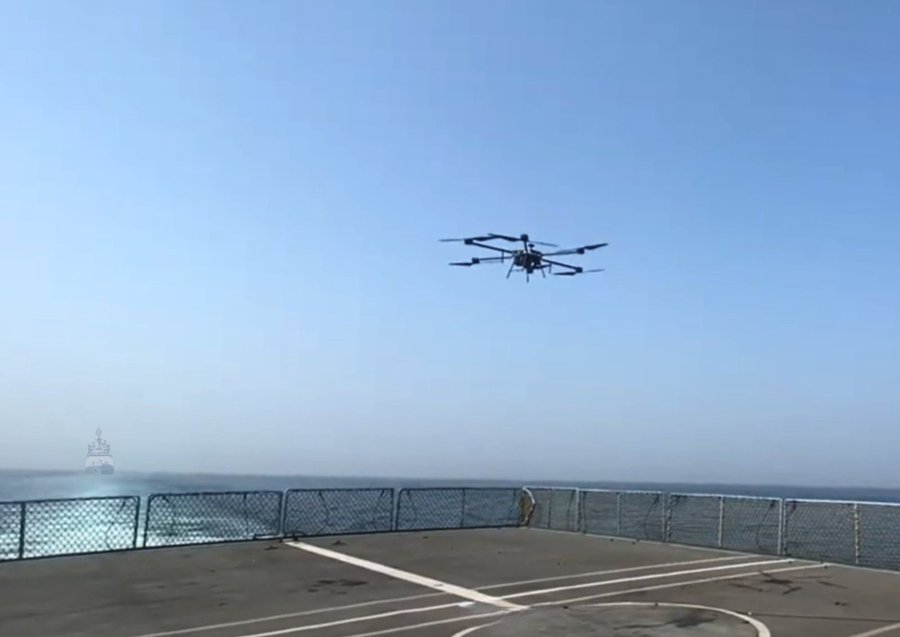The 40-hour-long high-octane drama that unfolded near Yemen as the Indian destroyer INS Kolkata intercepted a hijacked merchant vessel on its way to become piracy ‘mothership’ had been under the watchful eyes of an indigenous Spotter drone. These drones are now an integral part of Indian warships.
“We are glad to see them fired upon, as it saves lives,” Captain Nikunj Parashar, Co-founder and Managing Director of Sagar Defense Engineering, told the EurAsian Times. The Pune-based firm has supplied the Indian Navy with the first indigenous maritime Spotter Drone.
INS Kolkata, on spotting the hijacked vessel with 35 pirates and 17 crew members, deployed the drone to get a real-time picture. It was then a pirate was seen shooting at the drone.
Sixty of these drones have been procured and have become an integral part of Indian warships. During the trials, the drone took off at 20 knots to perform disengage maneuvers for spotting missions and landed back on India’s maiden indigenous aircraft carrier, INS Vikrant.
#IndianNavy thwarts designs of Somali pirates to hijack ships plying through the region by intercepting ex-MV Ruen.
The ex-MV Ruen, which had been hijacked by Somali pirates on #14Dec 23, was reported to have sailed out as a pirate ship towards conducting acts of #piracy on high… pic.twitter.com/gOtQJvNpZb
— SpokespersonNavy (@indiannavy) March 16, 2024
“All drones land and take off from a stationary point, such as an island or a fixed position. These drones can land and take off while the ship is moving and carrying out action at high speed. This technology is available only with two companies globally other than us,” Parashar elaborated. These drones can carry out long-range missions up to 20 km.
“The drone’s control can be transferred from one ship to another or Marcos (Marine Commandos) on their hand-held system,” Parashar added. Parashar himself has been a captain in the merchant navy, and his vessel was once chased by pirates in the Gulf of Aden.
In 2021, the Indian Navy signed a deal with Sagar Defence Engineering for 30 units of the Spotter drone, which will be delivered and inducted into the Indian Navy in 2022. In 2023, the Indian Navy re-ordered 60 more units of the Spotter drone.
The multi-copter drone has been designed and developed indigenously for the Indian Navy. It will enable the forces to have scheduled inspections to detect threats beforehand and share crucial information in real time to immobilize the threats. This could help save the lives of the armed forces personnel and plan the tactics during mission-critical situations.
The smaller UAVs launched from carriers and warships will increase the vessels’ surveillance range. They will also enhance the ship’s communication with other friendly vessels by relaying signals, especially from the dedicated naval communications satellite Rukmani. It will be a part of a large web of communications networks coordinating with other aircraft, ships, and satellites.
Indian Navy Is Bolstering Its Maritime Prowess
The Indian Navy inducted UAVs for sea operations in the 2000s. Israel made two variants of fixed-wing UAVs, namely Searcher and Heron. The shore-based Naval Squadrons operated these UAVs with electro-optic cameras and COMINT (Communication Intelligence).

An innovation for the Indian Navy allowed taking over the UAV’s command at mid-sea to another designated warship after it had been launched from shore. Thereafter, warships at sea can exploit the UAVs for intelligence, surveillance, and reconnaissance missions, and controls can be passed back to the land station for UAV recovery.
The 40-hour-long high-octane drama that unfolded near Yemen as the Indian destroyer INS Kolkata intercepted a hijacked merchant vessel on its way to become piracy ‘mothership’ had been under the watchful eyes of an indigenous Spotter drone. These drones are now an integral part… pic.twitter.com/juskgLVBCp
— EurAsian Times (@THEEURASIATIMES) March 18, 2024
The biggest advantage of shipborne drones is that the navies can forward deploy them at any given time.
The Indian Navy last year decided to induct the country’s first passenger-carrying drone, the ‘Varuna’, manufactured by Sagar Defence Engineering Private Limited. The drone was designed in collaboration with the Navy and can land and take off from moving warships.
The passenger drone, which can be remotely piloted or flown autonomously along predefined routes, can carry a variety of payloads between its landing gear. It can carry weights of up to 130 kg and travel 25 to 30 kilometers in half an hour. In case of malfunction, it has a ballistic parachute that can come up.
In 2022, Larsen and Toubro signed a Memorandum of Understanding (MoU) with a start-up to develop submarine-launched UAVs, which would play a crucial role in Anti-submarine warfare (ASW). Such UAVs can also assist in anti-mine operations, apart from the standard role of ISR for a submarine operating at periscope depths.
The Indian Navy has attempted to acquire shipborne UAS or drones over the last two decades. Several foreign players have pitched a wide range of shipborne drone systems since the mid-2000s to the Indian Navy.
In 2007, the Indian Navy even tested the popular Austrian Schiebel Camcopter off the Indian Patrol Vessel INS Sujata, but no deal could be signed.
The Indian Navy once partially funded a joint effort by state-owned Hindustan Aeronautics Limited (HAL) and Israel Aerospace Industries (IAI) to convert the Chetak helicopter into an autonomous drone platform due to its need for capabilities over time. The project was called Naval Rotary UAV (NRUAV), and it failed due to technological difficulties.
IAI even offered to try unmanning the well-known Dhruv helicopter platform in 2011, but the Indian Navy did not take it up on the proposal.
- Ritu Sharma has been a journalist for over a decade, writing on defense, foreign affairs, and nuclear technology.
- The author can be reached at ritu.sharma (at) mail.com
- Follow EurAsian Times on Google News